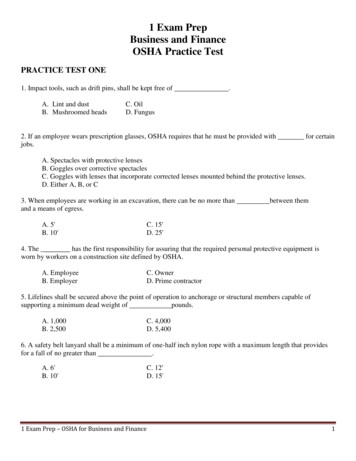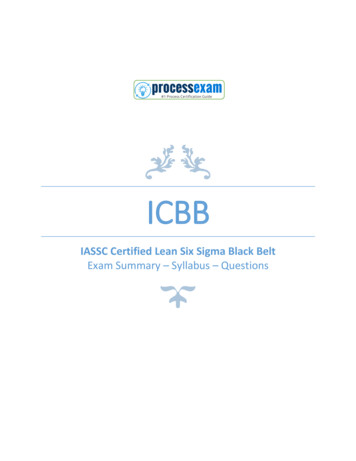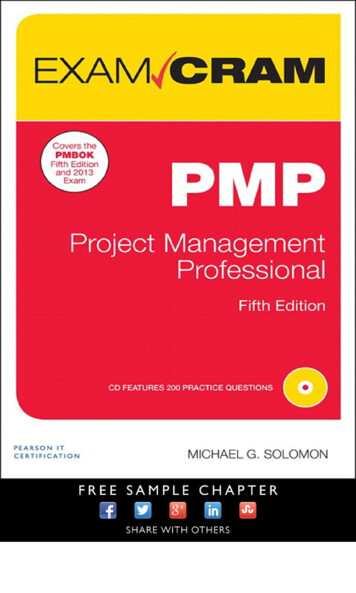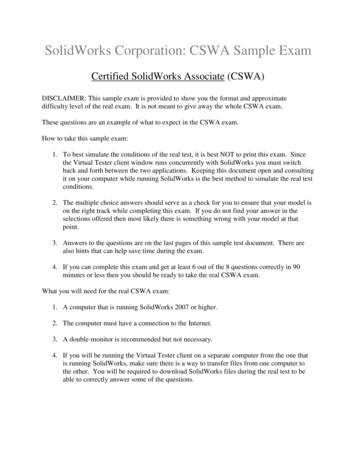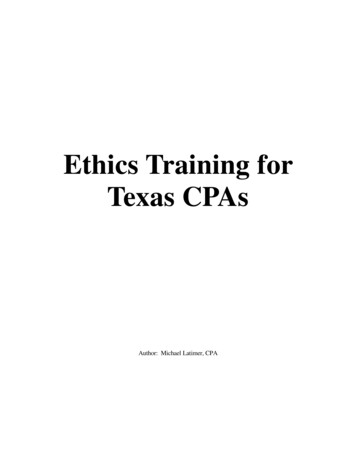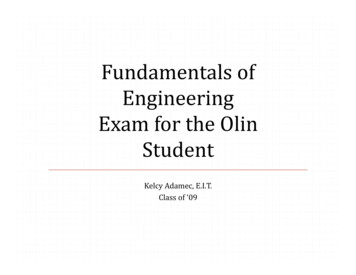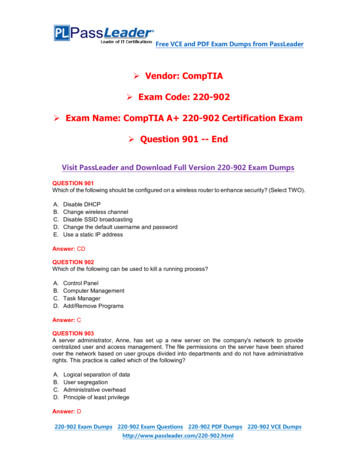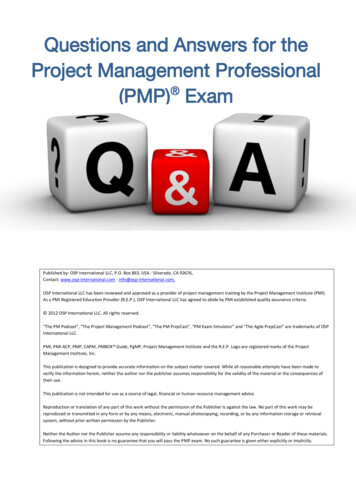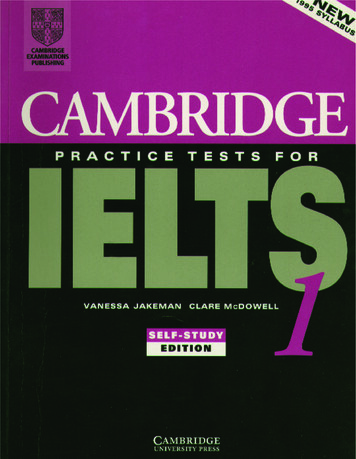
Transcription
i
Вторая страница обложкиii
CambridgePractice Tests forIELTS1Vanessa JakemanClare McDowellC AMBRIDGEUNIVERSITY PRESSiii
PUBLISHED BY THF PRESS SYNDICATE OF THE UNIVERSITY OF CAMBRIDGEThe Pitt Building Trumpington Street Cambridge CB2 1RP United KingdomCAMBRIDGE UNIVERSITY PRESSThe Edinburgh Building, Cambridge CB2 2RU, United Kingdom40 West 20th Street, New York, NY 10011-4211, USA10 Stamford Road, Oakleigh, Melbourne 3166, Australia Cambridge University Press 1996This book is in copyright. Subject to statutory exceptionand to the provisions of relevant collective licensing agreements,no reproduction of any part may take place withoutthe written permission of Cambridge University Press.First published 1996Third printing 1997Printed in the United Kingdom at the University Press, CambridgeISBN 0 521 49767 1 Self-Study Student s BookISBN 0 521 49766 3 Set of 2 cassettesCopyrightThe law allows a reader to make a single copy of part of a bookfor purposes of private study. It does not allow the copying ofentire books or the making of multiple copies of extracts. Writtenpermission for any such copying must always be obtained from thepublisher in advance.iv
ContentsAcknowledgements ivIntroduction1Practice Test 112Practice Test 234Practice Test 354Practice Test 475General Training Reading and Writing ModulesTapescriptsAnswer keys94107130Sample answer sheets153iiiv
AcknowledgementsWe would like to thank the staff and students of the following institutions for their assistance intrialling these materials:Wollongong English Language Centre; Australian College of English, Sydney; Hong KongPolytechnic; Waratah Education Centre, Sydney; International House, Queensland; MiltonEnglish Language Centre, Sydney; Oxford Academy of English.In addition, a number of our non-English speaking friends were kind enough to trial thematerials in their early formatsThe authors and publishers are grateful to the following for permission to reproduce copyrightmaterial.Focus magazine for the extract on pp. 20-21 from A spark, a flint: how fire lept to life; BBCWILDLIFE Magazine for the extract on pp. 24-5 from Showboat as Ark; The Guardian for theextract on pp. 28-9 from Architecture — Reaching for the Sky by Ruth Coleman and for thegraphs on pp. 31 and 72; Geoff Maslen for the extract on pp. 40-41 from The Rights of the Left,published by Good Weekend magazine; National Geographic magazine for the extract and mapon pp. 44-5 from America’s Beekeepers: Hives for Hire by Alan Mairson, National Geographic,May 1993, and for the extract on pp. 80-81 from Glass: Capturing the Dance of Light byWilliam S Ellis, National Geographic, December 1993; the extract on pp. 48-9 is reprinted fromThe Tourist Gaze, John Urry 1990, by permission of Sage Publications Ltd; The European forthe extract on pp. 60-61 from Spoken Corpus Conies to Life, for the extract on pp. 64-5 fromHobbits happy as homes go underground, and for the extract on pp. 84-5 from Why some womencross the finish line ahead of men by Andrew Crisp; The Royal Zoological Society of NewSouth Wales for the extract on pp. 87-8 from an article by Hugh Possmgham in Conservation ofAustralia’s Forest Fauna; Moulmex/Swan for the extract and illustrations on pp. 94-5 fromInstructions for a Moulmex Iron; Cambridge Coach Services for the extract on p. 96;International Students House for the extracts on p. 99 and p. 101 from the InternationalStudents’ A-Z: A guide to studying and living in London; Gore and Osment Publications for thediagram on p 51 and the extract on pp. 102-3 from The Science and Technology Project Book;BBC Good Food Magazine for the extract from Space Invaders, BBC Good Food Magazine,January 1995, on which Practice Test 3, Listening, Section 4 is based; University of Westminsterfor the extract from Getting it right: Essential information for international students on whichPractice Test 4, Listening, Section 2 is based: the IELTS Reading and Listening answer sheetsare reproduced by permission of the University of Cambridge Local Examinations Syndicate.Photographs p. 20 The Science Photo Library/Adam Hart Davis; p. 80 (top) Image Bank; p. 80(bottom) Damien Lovegrove.The illustration on p. 84 is reproduced by permission of Mm Cooper/The European.The drawings are by Julian Page. Maps and diagrams by HardLines.Book design by Peter Ducker MSTDThe cassette recording was produced by James Richardson at Studio AVP, Londoniv
IntrodutionIntroductionTO THE STUDENTAbout the bookThis book has been written for candidates preparing for the revised versionof the International English Language Testing System, known as IELTS.This is a test designed to assess the English language skills of non-Englishspeaking students seeking to study in an English speaking country.Aims of the book— to prepare you for the test by familiarising you with the types of textsand tasks that you will meet in the IELTS test, and the level and style oflanguage used in the test.— to help you prepare for your studies at university or collegeby introducing you to the types of communication tasks which you arelikely to meet in English speaking study environment.Content of the bookThe book contains four complete sample IELTS tests, each comprisingListening and Speaking modules and Academic Reading and Writing modules.In addition there is one set of the General Training Reading and Writingmodules. (NB all candidates do the same Listening and Speaking modules.)To accompany the tests there is an answer key at the back of the book and youshould refer to this after you have attempted each of the practice tests. Alsoincluded is an annotated copy of the listening tapescripts with the appropriatesections highlighted to help you to check your answers. In addition, you willfind one model answer for each type of writing task to guide you with yourwriting. There is a comprehensive key for the Reading and Listening sections,but if you are in any doubt about your answers, talk to a teacher or an Englishspeaking friend. Where you are required to answer in your own words, theanswer must be accurate in both meaning as well as grammar in order to bescored correct.Benefits of studying for IELTSBy studying for IELTS you will not only be preparing for the test but alsofor your future as a student in an English speaking environment. The testis designed to assess your ability to understand and produce written andspoken language in an educational context. The book makes reference tothe ways in which university study is organised in many English speakingcountries and the types of academic tasks you will be expected to perform.1
IntrodutionThese include: Reading and understanding written academic or training language Writing assignments in an appropriate style for university study or within a trainingcontext Listening to and comprehending spoken language in both lecture format as well asformal and informal conversational style Speaking to colleagues and lecturers on general and given topics in formal andinformal situationsDescription of the testThere are two versions of the IELTS test:Academic Modulefor students seeking entry to a university orinstitution of higher education offeringdegree and diploma coursesGeneral Training Modulefor students seeking entry to a secondaryschool or to vocational training coursesNote: All candidates must take a test for each of the four skills: listening,reading, writing and speaking. All candidates take the same Listening andSpeaking modules but may choose between the Academic or General Trainingversions of the Reading and Writing sections of the test. You should seekadvice from a teacher or a student adviser if you are in any doubt aboutwhether to sit for the Academic modules or the General Training modules.The two do not carry the same weight and are not interchangeable.Test formatListening 4 sections, around 40 questions 30 minutes transfer timeAcademic Reading 3 sections, around 40 questions 60 minutes OR GeneralTraining Reading 3 sections, around 40 questions 60 minutesAcademic Writing 2 tasks 60 minutes OR General Training Writing 2 tasks 60minutesSpeaking 10 to 15 minutesTotal test time 2 hours 45 minutes2
IntrodutionWHAT DOES THE TEST CONSIST OF?The Listening ModuleRequirementsSituation typesQuestion typesYou must listen to fourseparate sections and answerquestions as you listen. Youwill hear the tape once only.The first two sections arebased on socialsituations. There will bea conversation betweentwo speakers and then amonologue.You will meet a variety ofquestion types which mayinclude:· multiple choice· short answer questions· sentence completion·notes/summary/flowchart/table completion· labelling a diagramwhich has numbered parts· matchingThere will be between 38 and42 questions. The test willtake about 30 minutes. Therewill be time to read thequestions during the test andtime to transfer your answerson to the answer sheet at theend of the test.The level of difficulty of thetexts and tasks increasesthrough the paper.The second two sectionsare related to aneducational or trainingcontext. There will be aconversation with up tofour speakers and alecture or talk of generalacademic interest.Academic Reading ModuleRequirementsTypes of materialQuestion typesYou must read three readingpassages with a total of 1 500to 2 500 words.Magazines, journals,textbooks andnewspapers.There will be between 38 and42 questions. You will have60 minutes to answer all thequestions.Topics are not disciplinespecific but all are in astyle appropriate andaccessible to candidatesentering postgraduateand undergraduatecourses.You will meet a variety ofquestion types which mayinclude: multiple choice short answer questions sentence completion notes/summary/flowchart/table completion choosing from a bank ofheadings identification of writer sviews or attitudes (Yes/No/ Not given) classification matching lists matching phrasesThe level of difficulty of thetexts and tasks increasesthrough the paper.3
IntrodutionRequirementsTask typesTask IYou must completetwo writing tasks.You will have 60minutes to completeboth tasks.You will have to look at a diagram, a table or short piece of textand then present the information in your own words.You should spendabout 20 minutes onTask 1 and write atleast 150 words.Your writing will be assessed on your ability to: organise, present and compare data describe the stages of a process describe an object or event explain how something worksYou will also be judged on your ability to: Academic Writing Moduleanswer the question without straying from the topic write in a way which allows your reader to follow your ideas use English grammar and syntax accurately use appropriate language in terms of register, style andcontentYou should spendabout 40 minutes onTask 2 and write atleast 250 words.Task 2You will have to present an argument or discuss a problem.Your writing will be assessed on your ability to: present the solution to a problem present and justify an opinion compare and contrast evidence and opinions evaluate and challenge ideas, evidence or an argumentYou will also be judged on your ability to: communicate an idea to the reader in an appropriate style address the problem without straying from the topic use English grammar and syntax accurately use appropriate language in terms of register, style andcontent4
IntrodutionGeneral Training Reading ModuleRequirementsTypes of materialQuestion typesYou must answer questionson three sections ofincreasing difficulty with atotal of 1,500 to 2,500words.Notices, advertisements,booklets, newspapers,leaflets, timetables, booksand magazine articles.You will meet a variety ofquestion types, which mayinclude: multiple choice short answer questions sentence completion notes/summary/flowchart/table completion choosing from a bank ofheadings identification of writer’sviews or attitudes (Yes/No/Not given) classification matching lists matching phrasesThere will be between 38and 42 questions. You willhave 60 minutes to answerall the questions.The level of difficulty of thetexts and tasks increasesthrough the paper.Section 1Social survival —retrieving factualinformationSection 2Training survival —language in a trainingcontextSection 3General reading —extended prose withemphasis on descriptiveand instructive texts ofgeneral interest5
IntrodutionGeneral Training Writing ModuleRequirementsTask typesTask 1You must complete twowriting tasks. You willhave 60 minutes tocomplete both tasks.You should spend about20 minutes on Task 1 andwrite at least 150 words.You will have to write a short letter in response to a givenproblem or situation.Your writing will be assessed on your ability to: engage in personal correspondence elicit and provide general factual information express needs, wants, likes and dislikes express opinionsYou will also be judged on your ability to: answer the question without straying from the topic write in a way which allows your reader to follow yourideas use English grammar and syntax accurately use appropriate language in terms of register, style andcontentTask 2You should spend about40 minutes on Task 2 andwrite at least 250 words.You will have to present an argument or discuss a problem.Your writing will be assessed on your ability to: provide general factual information outline a problem and present a solution present and justify an opinionYou will also be judged on your ability to: communicate an idea to the reader in an appropriate style address the problem without straying from the topic use English grammar and syntax accurately use appropriate language in terms of register, style andcontent6
IntrodutionThe Speaking ModuleRequirementsAssessment criteriaYou will have to talk to an examiner for about 15 minutes.The interview will be recorded. It is in 5 parts:You will be assessed on thefollowing criteria: ability to communicateeffectively ability to use appropriatevocabulary and structures ability to ask questions ability to take initiative ina conversation general fluency structural accuracy intelligibility1 Introduction— Basic introductions2 Extended discourse— You will talk at some length about general topics ofrelevance or interest which will involve explanation anddescription.3 Elicitation— You will be given a cue card which describes asituation or problem. You must ask the examiner questions to obtain information.4 Speculation and attitudes— You will be asked to talk about your plans or proposed course of study. You should demonstrate yourability to speculate or defend a point of view.5 Conclusion— The interview comes to an end.How is IELTS scored?IELTS provides a profile of your ability to use English. In other words your IELTSresult will consist of a score in each of the four skills (listening, reading, writing,speaking) which is then averaged to give the Overall Band Score or final mark.Performance is rated in each skill on a scale of 9 to 1. The nine overall Bands andtheir descriptive statements are as follows:9 Expert userHas fully operational command of the language: appropriate, accurate and fluentwith complete understanding.8 Very good userHas fully operational command of the language with only occasionalunsystematic inaccuracies and inappropriacies. Misunderstandings may occur inunfamiliar situations. Handles complex detailed argumentation well.7
Introdution7 Good userHas operational command of the language, though with occasional inaccuracies, inappropriacies and misunderstandings in some situations. Generallyhandles complex language well and understands detailed reasoning.6 Competent userHas generally effective command of the language despite inaccuracies,inappropriacies and misunderstandings. Can use and understand fairly complex language, particularly in familiar situations.5 Modest userHas partial command of the language, coping with overall meaning in mostsituations, though is likely to make many mistakes. Should be able to handlebasic communication in own field.4 Limited userBasic competence is limited to familiar situations. Has frequent problems inunderstanding and expression. Is not able to use complex language.3 Extremely limited userConveys and understands only general meaning in very familiar situations.Frequent breakdowns in communication occur.2 Intermittent userNo real communication is possible except for the most basic information usingisolated words or short formulae in familiar situations and to meet immediateneeds. Has great difficulty understanding spoken and written English.1 Non userEssentially has no ability to use the language beyond possibly a few isolatedwords.0 Did not attempt the testNo assessable information provided.What is the pass mark?There is no fixed pass mark in IELTS. The institution you want to enter willdecide whether your score is appropriate for the demands of the course of studyor training you want to undertake. However, as a general rule, scores below Band5 in any one skill are considered too low for academic8
Introdutionstudy; scores above Band 6 are deemed to be adequate to good. Overall Bandscores of 5 or 6 are borderline and may not be acceptable at many institutions. Ifyou are getting only about half of the questions in these sample tests correct, thenyou are probably not quite ready to take the IELTS test. Again you should seekadvice from a teacher about your level of English. Remember you must allow aduration of at least 3 months between each attempt at the test.For further information about the test, see the IELTS Handbook available from alltest centres and also from UCLES (University of Cambridge Local ExaminationsSyndicate), from I DP Education Australia and from British Council Centres.HOW TO USE THIS BOOKThe tests in this book are similar in length, format and content to the real test, butsuccess in these tests will not guarantee success in the real test. It often seemseasier to work on practice materials than to sit the tests themselves because youare not under the same pressure.TimingIn order to maximise your use of these tests, you should make a note of the time ittakes you to answer each of the sections. As you progress through the book, bestricter with yourself about the time you allow yourself to complete the sections.Answer sheetsWhen you sit for the real IELTS test, you will have answer sheets on which towrite your answers. A sample of these is given at the end of this book. To help youprepare for the test, we suggest that you write your answers on separate sheets ofpaper, rather than in the book itself.Answer keysListeningIn addition to the answer key, you will find tapescripts for all of the listeningpassages. These have been annotated to show where in the text the answer to eachquestion can be found. There is very often a signpost word which will cue yourlistening. Look out for these signposts. Remember, the answers are usually shortand never more than three words. Read the questions carefully, in the timeprovided on the tape, before you listen to each section of the tape.9
IntrodutionReadingYou will meet a number of different question types in the IELTS test. It is auseful strategy to become familiar with them and learn how best to approachthem. The answer keys at the back of this book not only provide you with theanswer to each question, but also give a suggested approach to each type ofquestion, so take the time to work through them carefully.WritingYou will find four sample answers to the writing tasks, one for each task typeon each module. These have been included to give you an idea of the type ofwriting expected. However, there will be alternative approaches to eachquestion and the model answers given should not be seen as prescriptive.Look carefully at the description of the writing test (given above in theIntroduction) to see exactly which criteria you should be paying attention to ineach task.SpeakingThe sample speaking tasks are to help you prepare for part 3 of the Speakingtest. Remember that the examiner will expect you to show how much Englishyou know and it is up to you to demonstrate that. You are expected to ask a lotof questions in part 3 and the examiner will not speak very much and mayeven appear to be “unhelpful” at times, to encourage you to ask morequestions. The sample speaking tasks include suggested examiner’s promptsso that you can see how the interaction might unfold. It may be a usefulpreparation strategy to work with a friend and practise the interview format inthis way, using the sample tasks in the book.10
IntrodutionPractice Tests11
Practice Test 1LISTENINGSECTION 1Questions 1-10Questions 1-5Circle the appropriate letter.ExampleWhat has the woman lost?Aa briefcaseCa handbagBa suitcaseDa wallet1What does her briefcase look like?A2BBCWhat did she have inside her briefcase?AB12DWhich picture shows the distinguishing features?A3Cwallet, pens and novelpapers and walletCDpens and novelpapers, pens and novelD
Listening4Where was she standing when she lost her briefcase?A5BCDCDWhat time was it when she lost her briefcase?ABQuestions 6-10Complete the form Write NO MORE THAN THREE WORDS for each answer.PERSONAL DETAILS FORMName:Mary (6) .Address:Flat 2(7) . (8) . RoadCanterburyTelephone:(9) .Estimated value of lost item: (10) .
Practice Test 1SECTION 2Questions 11-21Questions 11-13Tick the THREE other items which are mentioned in the news headlines.NEWS HEADLINESARivers flood in the northExampleBMoney promised for drought victimsCNurses on strike in MelbourneDPassengers rescued from shipEPassengers rescued from planeFBus and train drivers national strike threatGTeachers demand more payHNew uniform for QANTAS staffINational airports under new management14ü
ListeningQuestions 14-21Complete the notes below by writing NO MORE THAN THREE WORDS in the spacesprovided.The Government plans to give (14) . to assist thefarmers. This money was to be spent on improving Sydney’s(15) . but has now been re-allocated.Australia has experienced its worst drought in over fifty years.Farmers say that the money will not help them because it is(16) . .An aeroplane which was carrying a group of (17) .was forced to land just (18) . minutes after take-off.The passengers were rescued by (19) . . Theoperation was helped because of the good weather. The passengersthanked the (20) . for saving their lives butunfortunately they lost their (21) . .
Practice Test 1SECTION 3Questions 22-31Questions 22-25Circle the appropriate letter.ExampleThe student is looking for the School ofABCD22The orientation meetingABCD23every morning.twice a week.three mornings a week.three afternoons a week.The lecturer’s name isABCD16optional after 4 pm.closely monitored.difficult to enforce.sometimes unnecessary.Tutorials take placeABCD25took place recently.took place last term.will take place tomorrow.will take place next week.Attendance at lectures isABCD24Fine Arts.Economic s.Robertson.
ListeningQuestions 26-31Complete the notes below using NO MORE THAN THREE WORDS.Course requirements:Tutorial paper: A piece of workgiven topic. Students must: (26) . for 2 5 minutesON A (27) . give to lecturer for markingEssay topic:Usually (28) .Type of exam:(29) .Library:Important books are in (30) . .Focus of course:Focus on (31) . .
Practice Test 1SECTION 4Questions 32-41Questions 32-33Circle the appropriate letter.32The speaker works within the Faculty ofABCD33Science and Technology.Arts and Social Sciences.Architecture.Law.The Faculty consists firstly ions 34-36Complete the notes m NO MORE THAN THREE WORDS.The subjects taken in the first semester inthis course are psychology, sociology,(34) . . and. . . .Students may have problems with(35) . . and(36) . . .18
ReadingQuestions 37-41Circle the appropriate letter.37The speaker says students can visit herABCDevery morning.some mornings.mornings only.Friday morning.38 According to the speaker, a tutorialABCD39When writing essays, the speaker advises the students toABCD40research their work well.name the books they have read.share work with their friends.avoid using other writers’ ideas.The speaker thinks that plagiarism isABCD41is a type of lecture.is less important than a lecture.provides a chance to share views.provides an alternative to groupwork.a common problem.an acceptable risk.a minor concern.a serious offence.The speaker’s aims are toABCDintroduce students to university expectations.introduce students to the members of staff.warn students about the difficulties of studying.guide students round the university.
Practice Test 1READING PASSAGE 1You should spend about 20 minutes on Questions 1-15 which are based on ReadingPassage 1 belowA spark, a flint: How fire leapt to lifeThe control of firewas the first andperhaps greatestof humanity’ssteps towards alife-enhancingtechnologyTo early man, firewas a divine giftrandomly deliveredin the form oflightning, forestfire or burning lava.Unable to makeflameforthemselves, theearliest peoplesprobabh stored fireby keeping slow burning logs alight or bycarrying charcoal in pots.How and where man learnt how to produceflame at will is unknown. It was probably asecondary invention, accidentally madeduring tool-making operations with wood orstone. Studies of primitive societies suggestthat the earliest method of making fire wasthrough friction. European peasants wouldinsert a wooden drill in a round hole androtate it briskly between their palms Thisprocess could be speeded up by wrapping acord around the drill and pulling on each end.The Ancient Greeks used lenses or concavemirrors to concentrate the sun’s rays andburning20glasses were alsoused by MexicanAztecs and theChinese.Percussionmethods of firelighting date backto Paleolithic times,when some StoneAge tool-makersdiscovered thatchipping flintsproduced sparks.Thetechniquebecamemoreefficient after thediscovery of iron,about 5000 vearsago In Arctic North America, the Eskimosproduced a slow-burning spark by strikingquartz against iron pyrites, a compound thatcontains sulphur. The Chinese lit their firesby striking porcelain with bamboo. InEurope, the combination of steel, flint andtinder remained the main method of firelighting until the mid 19th century.Fire-lighting was revolutionised by thediscovery of phosphorus, isolated in 1669by a German alchemist trying to transmutesilver into gold. Impressed by the element’scombustibility, several 17th century chemistsused it to manufacture fire-lighting devices,but the results were dangerouslyinflammable. With phosphorus costing the
Readingeqimalent of several hundred pounds perounce, the hrst matches were expensive.The quest for a practical match really beganafter 1781 when a group of French chemistscame up with the Phosphoric Candle orEthereal Match, a sealed glass tubecontaining a twist of paper tipped withphosphorus. When the tube was broken, airrushed in, causing the phosphorus to selfcombust. An even more hazardous device,popular in America, was the InstantaneousLight Box — a bottle filled with sulphuricacid into which splints treated with chemicalswere dipped.The first matches resembling those usedtoday were made in 1827 by John Walker,an English pharmacist who borrowed theformula from a military rocket-maker calledCongreve. Costing a shilling a box,Congreves were splints coated with sulphurand tipped with potassium chlorate. To lightthem, the user drew them quickly throughfolded glass paper.Walker never patented his invention, andthree years later it was copied by a SamuelJones, who marketed his product as Lucifers.About the same time, a French chemistrystudent called Charles Sauria produced thefirst “strike-anywhere” match by substitutingwhite phosphorus for the potassium chloratein the Walker formula. However, since whitephosphorus is a deadly poison, from 1845match-makers exposed to its fumessuccumbed to necrosis, a disease that eatsaway jaw-bones. It wasn’t until 1906 that thesubstance was eventually banned.That was 62 years after a Swedish chemistcalled Pasch had discovered non-toxic redor amorphous phosphorus, a developmentexploited commercially by Pasch’scompatriot J E Lundstrom in 1885.Lundstrom’s safety matches were safebecause the red phosphorus was non-toxic;it was painted on to the striking surfaceinstead of the match tip, which containedpotassium chlorate with a relatively highignition temperature of 182 degreescentigrade.America lagged behind Europe in matchtechnology and safety standards. It wasn’tuntil 1900 that the Diamond MatchCompany bought a French patent for safetymatches —
2 Introdution These include: Reading and understanding written academic or training language Writing assignments in an appropriate style for university study or within a training
